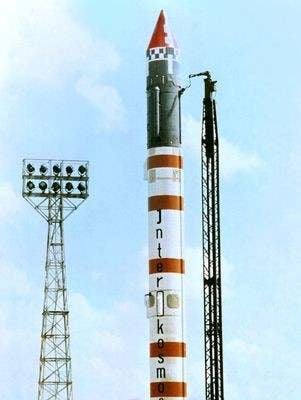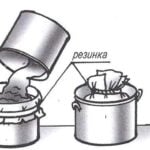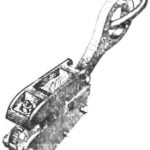 Dedicated to the memory of General designer Mikhail Kuzmich Yangelya. In issue No. 7 of 2000 published an article “the workhorse of the launch sites” dedicated booster light class — “Kosmos-3M”. It’s time to tell the readers more about the earlier work (now quite forgotten), the famous Dnepropetrovsk CB “South”— the first Russian carrier rocket light class that took indexes 63С1 and 11К63 and an open name “Kosmos-2”. In this article the author talks about the rocket when it is presented the detailed drawing, executed on full-scale model, on display in the National aerospace education center of Ukraine in Dnepropetrovsk.
Dedicated to the memory of General designer Mikhail Kuzmich Yangelya. In issue No. 7 of 2000 published an article “the workhorse of the launch sites” dedicated booster light class — “Kosmos-3M”. It’s time to tell the readers more about the earlier work (now quite forgotten), the famous Dnepropetrovsk CB “South”— the first Russian carrier rocket light class that took indexes 63С1 and 11К63 and an open name “Kosmos-2”. In this article the author talks about the rocket when it is presented the detailed drawing, executed on full-scale model, on display in the National aerospace education center of Ukraine in Dnepropetrovsk.
The story of this booster (PH) is from 1960, when he published a government resolution “On creation of the carrier rocket 63С1 on the basis of combat missile R-12, the development and launch of 10 small satellites” (satellites). This resolution approved a programme for space research, the proposed CB “South”, which then led to the academician, Chief designer Mikhail Kuzmich Yangel.
Design Bureau “South” was created in 1951 at Dnepropetrovsk plant No. 586 on the proposal of S. P. Korolev, when it began production of the first ballistic missile R-1, R-2, and further P-5. In 1953 M. K. Yangel was appointed Chief designer of KB, which included the creation of combat missiles on long-term storable propellants for the weapons of the strategic missile forces. The first private development of CB was ballistic medium-range missile R-12. Its creation was initiated by resolution of the government dated August 13, 1955 “On the creation and the manufacture of R-12 (8K63)”. The resolution provided for the beginning flight tests in April 1957 and set the range to 2000 km.
Experienced KB-586 in October released a revised draft design involving the use of technological equipment available at the “Yuzhmash” to R-5. This determined the diameter of the rocket in 1.65 m and a length of about 21 m. it has been used four-chamber liquid rocket engine (LRE) RD-214, developed in OKB-254 under the leadership of Chief designer V. P. Glushko. The engine used high-boiling fuel components — АК27И (27% solution of nitrogen tetroxide in nitric acid) and TM-185 (hydrocarbon fuel of the type of turpentine) with the ratio — of 3.97. The engine thrust at the ground was 63.5 tonnes, and in the vacuum of 73 tons, the pressure in the combustion chamber and 43.6 ATM, the duration of — 130 C. the Ignition was chemical with the use of starting fuel TG-02, filled to the appropriate line.
Rocket R-12 for the first time had completely Autonomous inertial control system. Bodies of flight controls was a gas graphite rudders. Rocket (top to bottom) consisted of the warhead, transition skirt, oxidizer tank, magbabago instrument compartment, fuel tank and tail section, with mounted on it starting supports and gas rudders. The use of the RD-214 had an impact on the appearance of the rocket had to enter the conical skirt fairing in the tail section, which had a favorable impact on the stability of the flight. In addition, for this purpose was installed and the fixed aerodynamic stabilizer.
“Dry bays” had a traditional riveted construction consisting of the power set and the skin that used aluminum alloy V-95 and D-16 respectively. Tanks are welded of aluminum alloy AMG-6. Each of them consisted of a cylindrical shell and two spherical heads. Shell formed of rings, which, in turn, welded from curved sheets of alloy. The material in the weld areas to compensate for the deterioration of the mechanical properties, had a bulge, made by chemical milling.
Launching complex for R-12 in many ways analogous to complex for the R-5 and developed state specialized KB “Spetsmash” under the leadership of Chief designer V. P. Barmin. Flight-design tests of R-12 began in June 1957 in Kapustin Yar and continued until December 1958, Only 25 rockets were fired. Missile ground-based R-12 in March of 1959, was adopted by the Soviet Army. It served as the basis for the creation of a new type of armed forces — the strategic Missile forces (RVSN). A government resolution was released in December 1959 he was the First commander of the strategic rocket forces became the Main Marshal of artillery M. I. Nedelin.
The next stage of the modernization of the R-12 missile was the development of a mine version of the R-12U, adopted by the strategic missile forces in January 1964, He was different from the basic rocket changed the design of the oxidizer tank and the lack of the aerodynamic stabilizer. During the serial production it was made about 2500 missiles R-12 and its modifications. The last of them was decommissioned in June 1989, During which time they were used not only on duty but also for launching model of an experimental reusable orbital raketoplana Bor-1 and Bor-2, for testing of missile defense systems and for the creation of the carrier rocket “Kosmos-2”.
When designing the booster 63С1 as the 1st stage was used without any changes to the R-12U and developed a new level 2 — C1. The head of the new media consisted of the nose cone and the satellite DS-1 is actually the 2nd stage and transitional farms.
For the 2nd stage were used in the research and production Association “Energomash” under the leadership of V. P. Glushko rocket engine RD-119. The engine used exotic fuel vapor — liquid oxygen and unsymmetrical dimethyl-hydrazine, with a ratio of 1.5. This, coupled with the high pressure of 78.9 ATM. in the combustion chamber gave the possibility to obtain very high specific impulse almost 3500 N*s/kg and it is still a matter of respect. The duration of the motor 260, the thrust in the void of 10.5 T. the engine is started fireworks. Separation of degrees “hot”, that is the engine of the 2nd stage is started before the end of the operation of the engine 1-th stage. To control the flight level is used in the turbopump Assembly gas, which expires in three pairs of stationary nozzle equipped with gas distribution device. In addition, part of this gas is used for tank pressurization.

The second stage PH includes a transition compartment, oxidizer tank, the instrument compartment, fuel tank, tail section and connecting the farm with the thermal protection of the oxidizer tank of the 1st stage. Each tank consists of a smooth cylindrical shell and the two spherical heads, welded from sheets of aluminum alloy AMG-6. “Dry bays” are the traditional riveted construction, aluminum alloy V-95 and D-16 (power set and the skin, respectively). The transition compartment is designed to accommodate the frame for the installation space of the apparatus and separate devices. The instrument compartment located control devices, which had then considerable dimensions. To this end, the housing compartment is made of four large hatches for installation and access to appliances.
The RD-119 housed in the tail section, and at the lower end of the — nozzle control system. To the bottom power the frame by bolts attached tubular connecting farm. It also serves for the free passage of gases when you start the rocket engine 2nd stage. The lower belt is attached to the heat shield of the oxidizer tank of the 1st stage, made of asatellite and having the form of a disk with a profiled cone of the Central part. When you separate the steps of the farm stays on the 1st stage.
Length PH “Kosmos-2” made up of 29.95 m, launch weight of 49.4 T. It is capable of outputting a payload of 450 kg into orbit. To run KB General engineering has developed two types of launch facilities — ground and silo. Flight tests were initiated in October 1961 from a silo at Kapustin Yar. The first two launches were unsuccessful. Third start, March 16, 1962 was successful. The carrier rocket put into orbit close to the calculated satellite DS-2, which has got an open name “Kosmos-1”. Until the end of 1965 was put into orbit 22 IS3 scientific and economic purposes.
By this time, at the Plesetsk cosmodrome was built fixed ground launch complex “rainbow”. The carrier rocket “Kosmos-2”, developed for the mine option, had a low wind resistance. Therefore, after the installation of the complex it was closed with a special service tower with a height of about 45 m. the First launch from this complex was made on 16 March 1967, Only made 163 run PH “Kosmos-2”. Of them successfully— 144. Just into orbit displayed 145 IS3, including under the program “Interkosmos”. The last launch from the Kapustin Yar cosmodrome on 19 APR 1974 with IS3 “Intercosmos-8”, and the last from Plesetsk — June 18, 1977 with the IS3 “Space-919”.
In further operation of the PH “Kosmos-2” was completed, in connection with adopting more sophisticated and powerful missiles “Space-ZM”. This was also due to the complexity of the operation PH “Kosmos-2”, connected with the abundance of different propellants and gases for fueling missiles.
Advice to the Modeler Rocket-carrier “Kosmos-2” can become the prototype for flying models-copies having sufficiently high characteristics for successful performance in the competition (class S7 on realism of the flight).
Such a model with its flight characteristics will be very close to published in the journal № 7, 2000-models PH “Kosmos-3M”. In the same way as there can be recommended for modeling PH “Kosmos-2” scale 1:40, which will allow the use of engines and construction diagram-models “Space-ZM”. This model is small and lightweight. But as the contest rules state the starting mass of the model in the class S7 can reach up to 1 kg, the scale may be increased.
Preliminary calculations show that it is possible to use the scale of 1:25, and 1 tier-four engine 20 mrad. The fundamental difference is only a sustaining 2nd degree. I recommend to use the embodiment of caudal and transitional compartments used in the model-copy PH “Soyuz-U2” published in journal No. 11, 2002, and No. 5, 2003.
Technical data PH “Kosmos-2”
Length, m ………………………………………………………………29,625
Maximum diameter, m……………………………………..2,003
Launch mass, t…………………………………………………..49,4
Payload, kg………………………………………………………450
Length of the 1st stage, m…………………………………………….18,615
The tanks diameter, m……………………………………………………..1,65
Dry weight, kg……………………………………………………….3150
Thrust rocket engine:
the earth, t………………………………………………………………63,5
in vacuum, t……………………………………………………………..73
The duration of the work……………………………………130
Length 2nd stage, m………………………………………………10,63
Dry weight, t………………………………………………………….0,84
Thrust rocket engine, t………………………………………………………………10,5
The duration of the work……………………………………260
V. MINAKOV, engineer
Literature
1. I. Afanas’ev. R-12 “sandalwood”.— Annex to the magazine “M-Hobby”. Vol. No. 9, 1997.
2. V. Putnicki etc. of Domestic carrier rockets.— SPb., Ed. center gmtu, 1996.
3. S. P. Umansky boosters. Spaceports. — M., “Restart Plus”, 2001.



